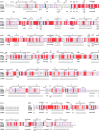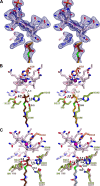Structural basis of the stereospecificity of bacterial B12-dependent 2-hydroxyisobutyryl-CoA mutase
- PMID: 25720495
- PMCID: PMC4392272
- DOI: 10.1074/jbc.M115.645689
Structural basis of the stereospecificity of bacterial B12-dependent 2-hydroxyisobutyryl-CoA mutase
Abstract
Bacterial coenzyme B12-dependent 2-hydroxyisobutyryl-CoA mutase (HCM) is a radical enzyme catalyzing the stereospecific interconversion of (S)-3-hydroxybutyryl- and 2-hydroxyisobutyryl-CoA. It consists of two subunits, HcmA and HcmB. To characterize the determinants of substrate specificity, we have analyzed the crystal structure of HCM from Aquincola tertiaricarbonis in complex with coenzyme B12 and the substrates (S)-3-hydroxybutyryl- and 2-hydroxyisobutyryl-CoA in alternative binding. When compared with the well studied structure of bacterial and mitochondrial B12-dependent methylmalonyl-CoA mutase (MCM), HCM has a highly conserved domain architecture. However, inspection of the substrate binding site identified amino acid residues not present in MCM, namely HcmA Ile(A90) and Asp(A117). Asp(A117) determines the orientation of the hydroxyl group of the acyl-CoA esters by H-bond formation, thus determining stereospecificity of catalysis. Accordingly, HcmA D117A and D117V mutations resulted in significantly increased activity toward (R)-3-hydroxybutyryl-CoA. Besides interconversion of hydroxylated acyl-CoA esters, wild-type HCM as well as HcmA I90V and I90A mutant enzymes could also isomerize pivalyl- and isovaleryl-CoA, albeit at >10 times lower rates than the favorite substrate (S)-3-hydroxybutyryl-CoA. The nonconservative mutation HcmA D117V, however, resulted in an enzyme showing high activity toward pivalyl-CoA. Structural requirements for binding and isomerization of highly branched acyl-CoA substrates such as 2-hydroxyisobutyryl- and pivalyl-CoA, possessing tertiary and quaternary carbon atoms, respectively, are discussed.
Keywords: (S)-3-Hydroxybutyryl-CoA; 2-Hydroxyisobutyryl-CoA; Adenosylcobalamin (AdoCbl); Crystal Structure; Pivalyl-CoA; Stereoselectivity; Substrate Specificity; X-ray Crystallography; acyl-CoA Mutase.
© 2015 by The American Society for Biochemistry and Molecular Biology, Inc.
Figures






References
-
- Banerjee R. (2003) Radical carbon skeleton rearrangements: catalysis by coenzyme B12-dependent mutases. Chem. Rev. 103, 2083–2094 - PubMed
-
- Erb T. J., Rétey J., Fuchs G., Alber B. E. (2008) Ethylmalonyl-CoA mutase from Rhodobacter sphaeroides defines a new subclade of coenzyme B12-dependent acyl-CoA mutases. J. Biol. Chem. 283, 32283–32293 - PubMed
-
- Ratnatilleke A., Vrijbloed J. W., Robinson J. A. (1999) Cloning and sequencing of the coenzyme B12-binding domain of isobutyryl-CoA mutase from Streptomyces cinnamonensis, reconstitution of mutase activity, and characterization of the recombinant enzyme produced in Escherichia coli. J. Biol. Chem. 274, 31679–31685 - PubMed
MeSH terms
Substances
Associated data
- Actions
LinkOut - more resources
Full Text Sources
Molecular Biology Databases

